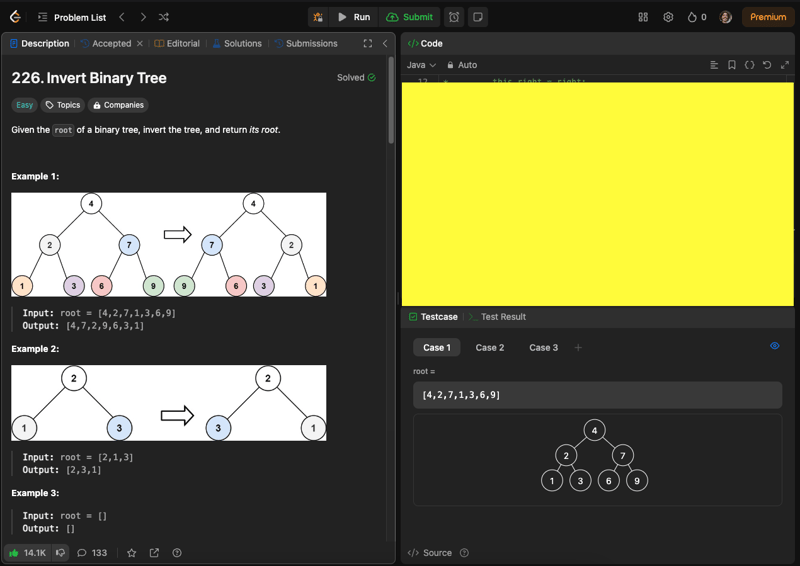Java 中的倒置二叉树
Recently, I started to practice some LeetCode exercises to improve my algorithm/data structure skills. I can say that the platform provides a good environment to practice and learn with other developers solutions in a several programming languages, discuss, share solutions with others and practice code challenges requested by big companies.
What is LeetCode?

LeetCode is a website that helps candidates to prepare for coding interviews. Users can practice challenges by using the platform's coding and algorithmic problems, alongside with predefined tests for candidate's solution. LeetCode has become a popular resource for technical interviews and coding competitions, alongside with HackerRank.
My routine solving problems
I put myself to the goal of solving at least 3 challenges per day, and my way of thinking in a solution involves my iPad, a pen for screens and the Freeform app. I try to draw and think about the solutions, and this is helping a lot in my code submissions. A lot of challenges sounds hard at first glance, but with a few minutes thinking and architecting the solution (I recommend writing your thinking process). If I can't find the right solution in 30 minutes, then I see the submission from other developers to discover where are my mistakes (sometimes a small step that I forgot in my code). Even if your solution is good enough, I highly recommend looking at other's submissions to think in another ways of solving that problem (some more or less eficient).
The Invert Binary Tree problem

Few days ago I faced the Invert Binary Tree problem at LeetCode, a well-known challenge requested in some interviews and a problem that I saw in when taking a Data Structures/Algorithms classes at the university. Although I never faced this challenge into an interview and haven't ever had explicitly to invert a binary tree in my work, knowing how to invert one gave me more experience with DS, Trees and algorithm thinking and practice some techniques like recursion.
I recommend you to try to solve this problem before reading the rest of this article
The solution
The Invert Binary Tree problem asked me to "Given the root of a binary tree, invert the tree, and return its root." (in other words, we should "mirror" the tree). I used Java programming language to submit a solution, but the steps are the same for other languages (with small syntax changes). The input example and expected output is shown below:

Input: root = [4,2,7,1,3,6,9] Output: [4,7,2,9,6,3,1]
We are going to use recursion technique to recursively call the invertTree() method, passing some side of the tree as a root. So, as every recursion asks, we need to define a stop condition where the recursion stack will finish and return the respective result of the recursion call. After, we just invert the sides of the tree, assigning to root.left the value returned by the recursion passing root.right as parameter, and do the same to root.right assigning the value of root.left recursion result. As we are modifying the original value, we need an auxiliary variable to store the original result of root.left (you probably implemented a code like this in university and called it swap() method.
At the end we return the root with the nodes inverted. You can check the code below:
/**
* Definition for a binary tree node.
* public class TreeNode {
* int val;
* TreeNode left;
* TreeNode right;
* TreeNode() {}
* TreeNode(int val) { this.val = val; }
* TreeNode(int val, TreeNode left, TreeNode right) {
* this.val = val;
* this.left = left;
* this.right = right;
* }
* }
*/
class Solution {
public TreeNode invertTree(TreeNode root) {
if(root == null) {
return null;
}
TreeNode aux = root.left;
root.left = invertTree(root.right);
root.right = invertTree(aux);
return root;
}
}
Keep in mind that could exist a lot of different solutions for different problems, and that's great. Everyone has a way of thinking and program, Data Structures domain etc. You don't need to follow this exact same code to solve this problem, but you must pay attention to the algorithm complexity (you can use 3 nested for to solve a problem, but this is less performative than using 1 for).
以上是Java 中的倒置二叉树的详细内容。更多信息请关注PHP中文网其他相关文章!

热AI工具

Undresser.AI Undress
人工智能驱动的应用程序,用于创建逼真的裸体照片

AI Clothes Remover
用于从照片中去除衣服的在线人工智能工具。

Undress AI Tool
免费脱衣服图片

Clothoff.io
AI脱衣机

Video Face Swap
使用我们完全免费的人工智能换脸工具轻松在任何视频中换脸!

热门文章

热工具

记事本++7.3.1
好用且免费的代码编辑器

SublimeText3汉化版
中文版,非常好用

禅工作室 13.0.1
功能强大的PHP集成开发环境

Dreamweaver CS6
视觉化网页开发工具

SublimeText3 Mac版
神级代码编辑软件(SublimeText3)
 公司安全软件导致应用无法运行?如何排查和解决?
Apr 19, 2025 pm 04:51 PM
公司安全软件导致应用无法运行?如何排查和解决?
Apr 19, 2025 pm 04:51 PM
公司安全软件导致部分应用无法正常运行的排查与解决方法许多公司为了保障内部网络安全,会部署安全软件。...
 如何将姓名转换为数字以实现排序并保持群组中的一致性?
Apr 19, 2025 pm 11:30 PM
如何将姓名转换为数字以实现排序并保持群组中的一致性?
Apr 19, 2025 pm 11:30 PM
将姓名转换为数字以实现排序的解决方案在许多应用场景中,用户可能需要在群组中进行排序,尤其是在一个用...
 IntelliJ IDEA是如何在不输出日志的情况下识别Spring Boot项目的端口号的?
Apr 19, 2025 pm 11:45 PM
IntelliJ IDEA是如何在不输出日志的情况下识别Spring Boot项目的端口号的?
Apr 19, 2025 pm 11:45 PM
在使用IntelliJIDEAUltimate版本启动Spring...
 如何使用MapStruct简化系统对接中的字段映射问题?
Apr 19, 2025 pm 06:21 PM
如何使用MapStruct简化系统对接中的字段映射问题?
Apr 19, 2025 pm 06:21 PM
系统对接中的字段映射处理在进行系统对接时,常常会遇到一个棘手的问题:如何将A系统的接口字段有效地映�...
 Java对象如何安全地转换为数组?
Apr 19, 2025 pm 11:33 PM
Java对象如何安全地转换为数组?
Apr 19, 2025 pm 11:33 PM
Java对象与数组的转换:深入探讨强制类型转换的风险与正确方法很多Java初学者会遇到将一个对象转换成数组的�...
 如何优雅地获取实体类变量名构建数据库查询条件?
Apr 19, 2025 pm 11:42 PM
如何优雅地获取实体类变量名构建数据库查询条件?
Apr 19, 2025 pm 11:42 PM
在使用MyBatis-Plus或其他ORM框架进行数据库操作时,经常需要根据实体类的属性名构造查询条件。如果每次都手动...
 如何利用Redis缓存方案高效实现产品排行榜列表的需求?
Apr 19, 2025 pm 11:36 PM
如何利用Redis缓存方案高效实现产品排行榜列表的需求?
Apr 19, 2025 pm 11:36 PM
Redis缓存方案如何实现产品排行榜列表的需求?在开发过程中,我们常常需要处理排行榜的需求,例如展示一个�...
 电商平台SKU和SPU数据库设计:如何兼顾用户自定义属性和无属性商品?
Apr 19, 2025 pm 11:27 PM
电商平台SKU和SPU数据库设计:如何兼顾用户自定义属性和无属性商品?
Apr 19, 2025 pm 11:27 PM
电商平台SKU和SPU表设计详解本文将探讨电商平台中SKU和SPU的数据库设计问题,特别是如何处理用户自定义销售属...






